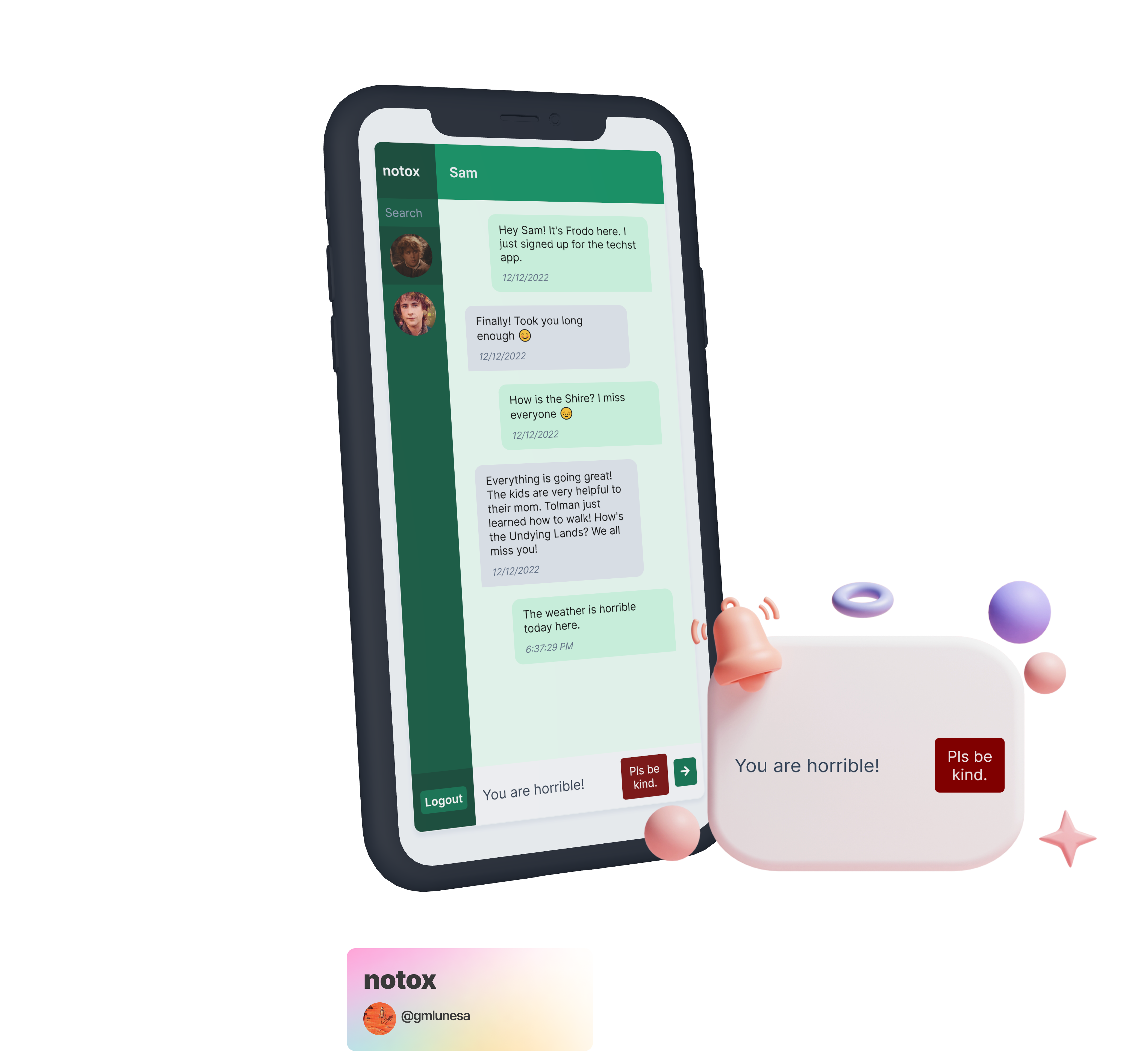Along with the growing accessibility of the internet across the world, offensive actions across the virtual space have also become increasingly prevalent. According to Pew Research, roughly 4 in 10 Americans have experienced online harrassment. Through machine learning, we can help to improve user experience to avoid negative interactions.

Using machine learning models
In this blog post, I will provide a walkthrough on how to integrate and use a machine learning model in a chat application to prevent rude messages from being sent. Of course, there is a simple option to identify toxic messages by checking if the message contains a word that is deemed inappropriate. However, this approach may overlook semantic context and may misclassify the message. Take these two sentences for example:
- The weather is horrible.
- You are horrible.
If the word horrible was in the list of inappropriate words, the first sentence will be misclassified as toxic. Context matters, hence we will harness the power of machine learning to take this a step further.
This project will be using a pre-trained TensorFlow model from Tensorflow.js. The model detects whether the text contains toxic content such as threatening language, insults, obscenities, identity-based hate, or explicit language. It is built on top of the Universal Sentence Encoder (Cer et al., 2018), a model that encodes text into 512-dimensional embedding and uses the Transformer (Vaswani et al, 2017) architecture, which is a state-of-the-art method for modelling language.
The model will then be integrated to a React chat application that is bootstrapped with Techst, a plug and play chat platform template.
Chat platform setup
Clone the Techst repository (alternative: Create a repository from a template - GitHub Docs)
git clone https://github.com/gmlunesa/techst.gitInstall Node modules
npm installGo to the Firebase Console.
- Add a project.
- Add
AuthenticationwithEmail/Passwordas theSign-in method. - Add a
Firestore Database. Add a
Storage.Add a
Webapplication.Copy the Firebase configuration that has been generated.
Open the
firebase.sample.jsfile, paste and replace the Firebase configuration under the// TODO: Replacecomment.// TODO: Replace apiKey: 'YOUR_API_KEY', authDomain: 'YOUR_AUTH_DOMAIN', projectId: 'YOUR_PROJECT_ID', storageBucket: 'YOUR_STORAGE_BUCKET', messagingSenderId: 'YOUR_MESSAGING_SENDER_ID', appId: 'YOUR_APP_ID',Rename the
firebase.sample.jsfile tofirebase.js.
Tensorflow Integration
Now that the chat application is up and running, we can now incorporate Tensorflow in our app.
Install relevant Tensorflow packages
npm install @tensorflow/tfjs @tensorflow-models/toxicityOpen
src/components/Input.jsImport the load method from the Toxicity model.
// Input.js import { load } from "@tensorflow-models/toxicity";Inside the functional component, add the following states.
// Input.js const [isToxic, setIsToxic] = useState(false); const [isClassifying, setIsClassifying] = useState(false); const [hasLoaded, setHasLoaded] = useState(false);isToxic: variable to contain the toxicity assessment from modelisClassifying: variable to keep track of the classification processhasLoaded: variable to keep track whether the model has loaded
Inside the functional component, insert the useRef hook.
// Input.js const model = useRef(null);model: retain the Tensorflow model that will persist for the full lifetime of the Input component
Inside the functional component, insert the useEffect hook.
// Input.js useEffect(() => { async function loadModel() { const threshold = 0.9; model.current = await load(threshold); setHasLoaded(true); } loadModel(); }, []);Inside the useEffect hook, we load the model through the
loadmethod from Tensorflow, which accepts an optional parameterthreshold. Its default value is0.85, but we will tweak it to0.9.The
loadmethod also loads the topology and weights, and returns a Promise which is resolved with the model.Topology: a file describing the architecture of a model (what operations it uses) and containing references to the model's weights which are stored externally.
Weights: binary files containing the model's weights, usually stored in the same directory as topology.
Source: Tensorflow
Inside the functional component, add the following code at the top of the
handleSendmethod.// Input.js // Set state variables setIsSending(true); setIsClassifying(true); const predictions = await model.current.classify([text]); setIsClassifying(false); const toxicityResult = predictions[6].results[0].match; // Set the state variable with the final prediction result setIsToxic(toxicityResult); if (!toxicityResult) { // Move the message sending code here }The
classifymethod takes a parameter of a string array to be evaluated to predict the toxicity. It returns a Promise that is resolved with apredictionsarray.The
predictionsarray is an array of objects containing the probabilities for each label. A label is what the TensorFlow model can provide predictions for:identity_attack,insult,obscene,severe_toxicity,sexual_explicit,threat, andtoxicity. For each toxicity label, there is an array of raw probabilities for each input sentence along with the final prediction. The final prediction can be any of the following:trueif the probability of a match exceeds the confidence threshold,falseif the probability of not a match exceeds the confidence threshold, andnullif neither probability exceeds the threshold.
We will be getting the final prediction value from the
toxicitylabel, which is the seventh item in the array, hencepredictions[6].results[0].match.
We are done with incorporating the TensorFlow model in our code! The next step would be to use the prediction result to show a reminder or not.
// Input.js { isToxic && <ChatReminder>Pls be kind.</ChatReminder>; }
That is it! If a user attempts to send a toxic message, it will filtered out by the machine learning model and will not be sent. A more positive space has now been created 🌱.
Next steps
While this is an exciting project, running the model and its classification process in the browser's main thread might pose some blockages in the application. I will be looking into the Web Workers API - Web APIs | MDN to separate the model's processing logic.
Here are some useful links that you may want to check out:

